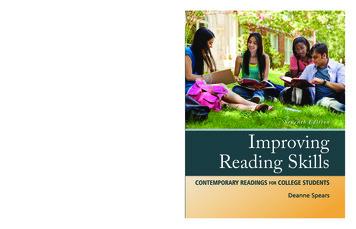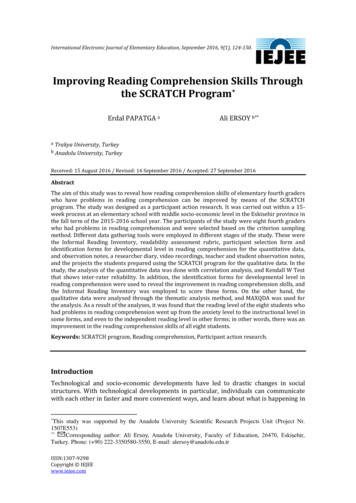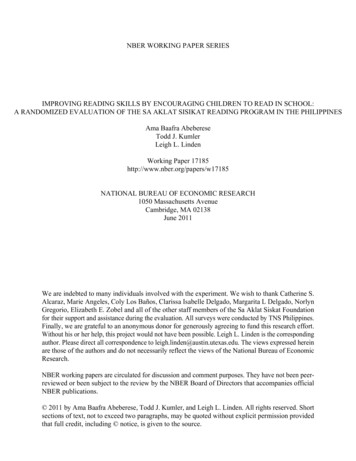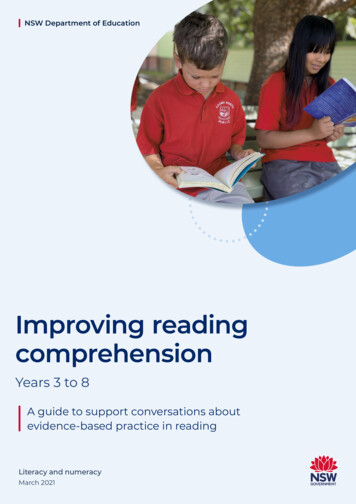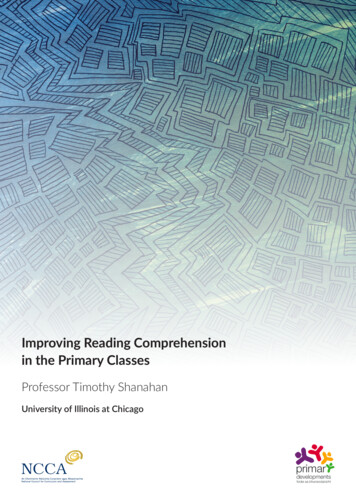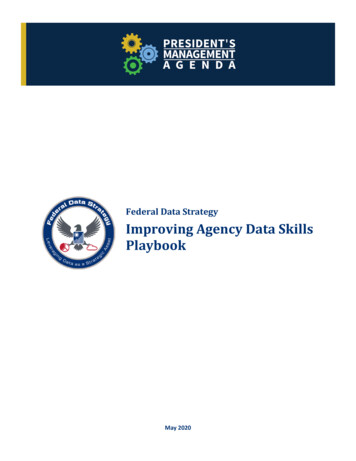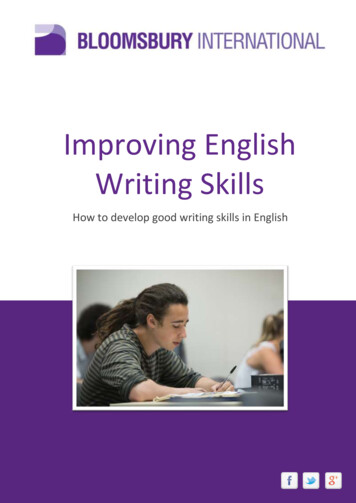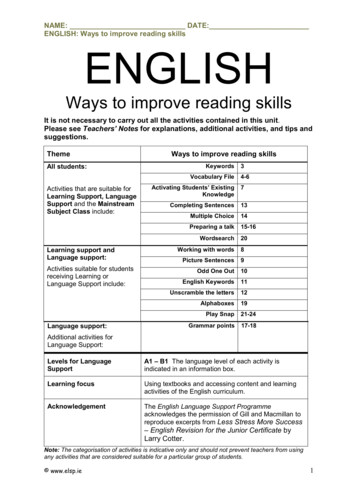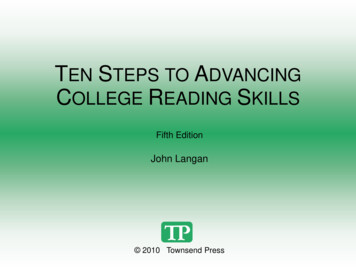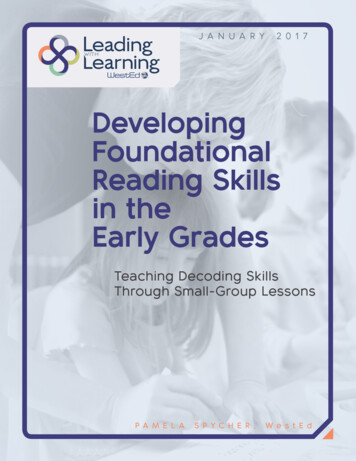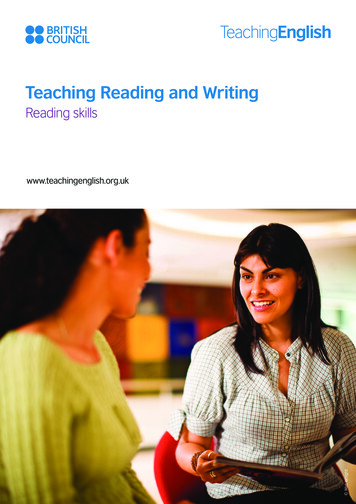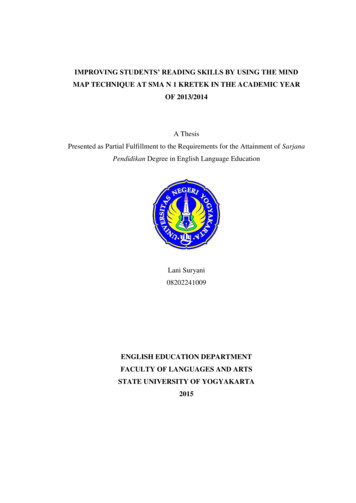
Transcription
IMPROVING STUDENTS’ READING SKILLS BY USING THE MINDMAP TECHNIQUE AT SMA N 1 KRETEK IN THE ACADEMIC YEAROF 2013/2014A ThesisPresented as Partial Fulfillment to the Requirements for the Attainment of SarjanaPendidikan Degree in English Language EducationLani Suryani08202241009ENGLISH EDUCATION DEPARTMENTFACULTY OF LANGUAGES AND ARTSSTATE UNIVERSITY OF YOGYAKARTA2015i
IMPROVING STUDENTS’ READING SKILLS BY USING THE MINDMAP TECHNIQUE AT SMA N 1 KRETEK IN THE ACADEMIC YEAROF 2013/2014A ThesisPresented as Partial Fulfillment to the Requirements for the Attainment of SarjanaPendidikan Degree in English Language EducationLani Suryani08202241009ENGLISH EDUCATION DEPARTMENTFACULTY OF LANGUAGES AND ARTSSTATE UNIVERSITY OF YOGYAKARTA2015i
APPROVAL SHEETIMPROVING STUDENTS’ READING SKILLS BY USING THE MINDMAP TECHNIQUE AT SMA N 1 KRETEK IN THE ACADEMIC YEAROF 2013/2014A ThesisBy:Lani Suryani08202241009Approved on February 4th, 2015First SupervisorSecond SupervisorDr. Agus Widyantoro, M. Pd.Siti Mahripah, S. Pd., M. App. Ling.NIP. 19600308 198502 1 001NIP. 19800913 200501 2 001ii
RATIFICATIONIMPROVING STUDENTS’ READING SKILLS BY USING THE MINDMAP TECHNIQUE AT SMA N 1 KRETEK IN THE ACADEMIC YEAROF 2013/2014By:Lani Suryani08202241009Accepted by the board of Examiners of Language and Arts Faculty, StateUniversity of Yogyakarta on February 24th, 2015 and declared to have fulfilled therequirements for the attainment of the degree of Sarjana Pendidikan in EnglishLanguage DepartmentBoard of ExaminersChairperson : Drs. Samsul Maarif, M. A.1. .Secretary: Siti Mahripah, S. Pd. M. App. Ling. 2. .Examiner 1: Siti Sudartini, S. Pd., M. A.3. .Examiner 2: Dr. Agus Widyantoro, M. Pd.4. .Yogyakarta, February 2015Faculty of Languages and ArtsState University of YogyakartaDean,Prof. Zamzani, M. Pd.NIP. 195505051980111001iii
PERNYATAANYang bertanda tangan di bawah ini, saya:Nama: Lani SuryaniNIM: 08202241009Program Studi: Pendidikan Bahasa InggrisJurusan: Pendidikan Bahasa InggrisFakultas: Bahasa dan SeniJudul Thesis: IMPROVING STUDENTS’ READING SKILLS BYUSING THE MIND MAP TECHNIQUE AT SMA N 1KRETEK IN THE ACADEMIC YEAR OF 2013/2014menyatakan bahwa karya ilmiah ini adalah hasil pekerjaan saya sendiri, dansepanjang pengetahuan saya tidak berisi materi yang telah dipublikasi atau ditulisoleh orang lain, kecuali pada bagian-bagian tertentu yang saya ambil sebagaiacuan dengan mengikuti tata cara dan etika penulisan karya ilmiah yang lazim.Apabila terbukti bahwa pernyataan ini tidak benar, hal ini sepenuhnyamenjadi tanggung jawab saya.Yogyakarta, Februari 2015Penulis,Lani SuryaniNIM. 08202241009iv
DEDICATIONSThis bunch of knowledge is lovingly dedicated to:My beloved parents for their priceless love and prayers*Mama Lasinah & Bapak Parmo*and*Mama Ana Kartiana & Bapak Yoyo Sujaya*My dearest one, my husband, for his love, patience, andmotivation in my ups and downs*Aa Lukman Farid*My lovely sisters and brother for their motivation and prayers*De Dani, De Erni, and De Arif*v
MOTTOSSo, verily, with every difficulty, there is relief.Verily, with every difficulty there is relief.(Q. S. Al Insyirah: 5-6)Do your best!(The writer)vi
ACKNOWLEDMENTSAlhamdulillahirobbil‟alamin, all praises be to Allah SWT who has giventhe writer remarkable blessings and strengths, so that I could finish this thesis. Inthis opportunity, I would like to express my deepest and sincere gratitude incompleting this thesis to the following parties.1. My first supervisor, Dr. Agus Widyantoro, M. Pd., who has guided andencouraged me during the process of doing the research and writing thisthesis with all his patience.2. My second supervisor, Siti Mahripah, S. Pd., M. App. Ling., who has guidedme patiently during the process of writing this thesis.3. My academic consultant, Ari Purnawan, M. Pd. and all of my lectures inEnglish Education Department who have guided and taught me kindly andpatiently during my study.4. My beloved parents, Mama Las & Bapak Parmo and Mama Ana & BapakYoyo, for the warm love and endless supports and prayers.5. My dearest one, Aa Lukman Farid, for his patience, love, and prayers.6. My guide in the school, Ms. Yuana, where I conducted my research who waswillingly to be collaborator and observer in my research.7. My friends in class A 2008 members who motivated me during my study.8. My friends in 08 MNJ, Khoir, Lingkar Falisha, UmDi #2, AL HUDA, LaskarSemangka, ADK UNY, Fathiyya, Ulya‟, Asrama Aceh, and SANTIKERSDIY for their prayers and supports.9. Some participants who cannot be mentioned one byone here and who have given me support andcontribution during the completion of my researchand the thesis writing.Finally, I hope this thesis will have some contributions and be useful nomatter how small and imperfect it is.Yogyakarta, February 2014Lani Suryanivii
TABLE OF CONTENTSTITLE . iAPPROVAL . iiRATIFICATION . iiiPERNYATAAN . ivDEDICATIONS . vMOTTOS . viACKNOWLEDGMENTS . viiTABLE OF CONTENTS . viiiLIST OF APPENDICES . xiiLIST OF TABLES . xiiiLIST OF FIGURES . xivABSTRACT . xvCHAPTER I: INTRODUCTION . 1A. Background of the Study . 1B. Identification of the Problem . 3C. Delimitation of the Problem . 5D. Formulation of the Problem . 5E. Objective of the Study . 6F. Significances of the Study . 6CHAPTER II: LITERATURE REVIEW . 7A. Theoretical Review . 71. Reading . 72. Reading Skill . 103. Reading Technique . 134. Teaching Reading . 155. Types of Classroom Reading Performance . 196. Teaching Reading in SMA . 20a. Aims of Teaching English in SMA . 21b. Characteristics of the Learner . 22viii
7. The Mind Map Technique . 23a. Definition . 23b. Benefits of Using the Mind Map to TeachReading Skills . 25c. How to Make Mind Map . 26B. Review of Related Studies . 28C. Conceptual Framework . 29CHAPTER III: RESEARCH METHOD . 32A. Type of Research . 32B. Research Setting . 33C. The Participants of the Research . 34D. Data collection . 341. Research Instruments of Data Collection. 352. Data Collection Technique . 35a. Interview . 35b. Observation . 36c. Documentation . 363. Data Analysis Technique . 36a. Assembling the data . 36b. Coding the data . 37c. Comparing the data . 37d. Building interpretations . 37e. Reporting the outcomes . 37E. Validity and Reliability . 381. Validity . 38a. Democratic Validity . 38b. Outcome Validity . 38c. Process Validity . 39d. Dialogic Validity . 392. Reliability . 39F. Research Procedures . 40ix
1. Planning . 412. Actions and Observations . 413. Reflection . 41CHAPTER IV: RESEARCH FINDINGS AND DISCUSSION . 43A. Reconnaissance . 431. Identification of the field problems . 432. Determining the actions to solve the field problems . 473. The relationship between the field problemsand the actions . 47B. The Implementation of the Actions . 481. The Report of Cycle I . 48a. Planning . 48b. Actions and Observation . 511) First Meeting . 512) Second Meeting . 57c. Reflection . 601) The Successful Actions . 602) The Unsuccessful Actions . 612. The Report of Cycle II . 62a. Planning . 62b. Actions and Observations . 631) First Meeting . 632) Second Meeting . 683) Third Meeting . 71c. Reflection . 731) The Successful Actions . 732) The Unsuccessful Actions . 75C. General Findings . 75D. Discussion . 77CHAPTER V: CONCLUSIONS, IMPLICATIONS, AND SUGGESTIONS 80A. Conclusions . 80x
B. Implications . 81C. Suggestions . 82REFERENCES . 81APPENDICES . 84xi
LIST OF APPENDICESAppendix A: Course Grid . 88Appendix B: Lesson Plans . 94Appendix C: Field Notes . 109Appendix D: Interview Transcripts . 119Appendix E: Students‟ Portofolio . 122Appendix F: Photographs . 127Appendix G: Letters . 134xii
LIST OF TABLESTable 1: Reading Skills and the Purposes . 12Table 2: The Field Problems in Class XI IPA 1SMA N 1 Kretek Yogyakarta . 44Table 3: The Problems Related to the Process ofReading Teaching and Learning . 45Table 4: The Correlation between the Main Causes andthe Classified Problems . 46Table 5: The Relationship between the Field Problems and the Actions . 48xiii
LIST OF FIGURESFigure 1: Types of Classroom Performance . 20Figure 2: How to Make Mind Map . 28Figure 3: Conceptual Framework . 31Figure 4: Kemmis and McTaggart‟s Concept of Action Research . 32Figure 5: A student‟s work . 55Figure 6: Folktales Pictures . 56Figure 7: The students are doing an assignment in a group . 59Figure 8: The students are checking the unknown wordsin the dictionary . 66Figure 9: The student‟s work . 67Figure 10: The student‟s work . 70Figure 11: The student is making a mind map . 72Figure 12: A student‟s work . 74Figure 13: A student‟s paraphrasing work . 74xiv
IMPROVING STUDENTS’ READING SKILLS BY USING THE MINDMAP TECHNIQUE AT SMA N 1 KRETEK IN THE ACADEMIC YEAROF 2013/2014ByLani Suryani08202241009ABSTRACTThe nature of this study is action research. This study aimed at improvingthe students‟ reading skills by using the mind map technique in the process ofreading teaching and learning.This research consisted of two cycles. It was conducted collaborativelywith the English teacher. The subjects of this research were 25 students of classXI IPA 1 in SMA N 1 Kretek, Bantul, Yogyakarta. The data in this research werecollected through observations, interviews, and documentations. The data were inthe form of fieldnotes, interview transcripts, photographs, and students‟portofolios. The researcher used qualitative method in analysing the data. Theresearcher also enhanced the trustworthiness of the data and the subjectivity byusing the two forms of triangulation: timeand researcher triangulation.The result of the two cycles showed that the use of the mind maptechnique could improve the students‟ reading skills. The students gotimprovements in the paraphrasing sentence, finding topic sentence, andvocabulary mastery. Moreover, through the mind map technique, the studentswere motivated to be active in the classroom activities. They were activelyinvolved in the process of teaching and learning. This condition stimulated thestudents to work based on their own actual capability. Thus, the students got moreexperiences and improved their achievement.Keywords: reading skills, mind map techniquexv
CHAPTER IINTRODUCTIONA. Background of the StudyEnglish is one of some international languages which is used by mostpeople around the world. In a global era, people are expected to master English sothat they can communicate with other people who live in other countries. As atool of an international communication, it should be learned by people who live ina country which uses English as a foreign language, including Indonesia. Tosupport Indonesian people in order to be able to communicate with other peoplearound the globe, Indonesian government incorporates English into its educationalcurriculum as one of its compulsory subjects starting from junior high school.Hence, it is hoped that there will be a great chance for Indonesian learners toimprove their English communication competence.Learning language covers some aspects. One of the important aspects islinguistic aspect which covers grammar, vocabulary, pronunciation, structure, andso on. Beside those aspects, the learners also need to master the skills of thelanguage such as listening, writing, reading, and speaking. However, it should bekept in mind that those skills cannot be learned discretely. Students who arelearning English should master those skills integratedly.It has been known that the students tend to face written texts every day.The written texts could be found in magazines, newspaper, books, articles onpaper and internet, and other kinds of the written texts. Those written texts give so1
2much information for the learners. In school setting, texts are widely presented inthe learners‟ textbooks.In some school setting, the students get some English textbooks which arewritten in English. These textbooks contain a lot of information related to thesubjects the learners learned. In order to access this information, therefore theyneed sufficient knowledge of English. Especially, they should have the skills ofreading because it is written in the textbooks so that they could comprehend itwell. That is why the reading skills are important to be mastered.However, in some schools, the researcher found that there were manylearners who still had low reading skills. It was proven when the researcherobserved a learning process in a school named SMA N 1 Kretek. They faced somereading problems which caused the learners had difficulties in comprehending theinformation presented in the textbooks.Reading is a complex process, complex to learn and complex to teach(Carnine, Silbert, and Kameenui: 1990:3), so there must be a technique which canhelp them to read effectively and interestingly. Teaching comprehension strategiesexplicitly was seen as a possible approach to tackle the problems faced by thestudents. In this case, the writer tried to find interesting and effective way for thestudents and the teachers so that they can do their reading activity well. One oftechniques which are available is the mind map technique. By using thistechnique, the students were able to communicate information because it canclarify complex concepts into simple, meaningful displays so that the students can
3develop a holistic understanding of the content to be learned (Siriphanich andLaohawiriyano: 2010)Considering the problems discussed above, the reading has an importantrole to help the learners to comprehend a text they read. From the preliminaryobservation done by the researcher, it could be known that in the school, thelearners had some problems in reading. Consequently, it is necessary to conduct aresearch on improving the students‟ reading skills by using the mind maptechnique. It allows the students to imagine and explore associations between theconcepts in a passage they read (Davies, 2010). When the students can representor manipulate a complex set of concepts of the passage in a diagram, they aremore likely to understand those relationships, remember them, and be able toanalyse the component parts of the text. The researcher focused on reading skillsin class XI IPA 1 of SMA N 1 Kretek because the students‟ reading skills werestill low.B. Identification of the ProblemThere were a number of prominent problems related to the learners‟reading skills. These problems must be solved so that the students reading skills inclass XI IPA 1 in SMA N 1 Kretek could be improved. There were some factorswhich caused these problems. Those factors did not come only from the students,but also from other components of the teaching learning process. All of the factorswere related to each other.The researcher observed the class of XI IPA 1 in SMA N 1 Kretek toidentify the problems. This observation showed some problems which
4encouragedthe researcher to conduct a research. The researcher did not onlyobserve the class, but also interviewed the teacher and the students to get furtherinformation about the teaching and learning process. From the activities whichwere found, there were some important problems to be solved which existed in theclassroom which involved the learning process, the students, and the teachingtechnique.Firstly, the students did not get adequate guideline to the students how toread a text effectively. They were just given a text and asked to read. After that,they had to answer some questions about the text. It made the students feel boredand did not enjoy the lesson, so they only did the assignment carelessly. Theprocess of teaching also could not handle the students who made noise in theclassroom because there was less students‟ involvement.Secondly, the students had low motivation to read a text. Moreover,reading was an activity that the students disliked much. They were not interestedin the reading activity, such as doing assignment and homework. The studentsalso did not master vocabulary well. As a consequence, they got difficulty ininterpreting the meanings of the difficult words. They guessed the wordscarelessly. The students did not use their dictionary in finding the meaning ofunknown words. Meanwhile, the students had low reading skills. As aconsequence, there were students who did not pay attention to their teacher‟sexplanation. In addition to those problems, the students also often made noise inthe classroom. Finally, they were not able to find the topic of the text and itssupporting information.
5Lastly, the way they read text was monotonous. There was not aninnovative way for the learners to read a text comprehensively. The students couldnot learn effectively without the teacher‟s guidance. When the teacher used anappropriate technique which could overcome those problems that were identified,the students could be more active and interested in the reading activity. Therefore,it needs a technique to solve those problems identified above.C. Delimitation of the ProblemIt was impossible to solve all of the problems identified above. Therefore,the researcher limited the problems related to the use of teaching technique. It waschosen as the problem to be solved in this study because it was able to create aprocess of teaching English creatively, actively, and effectively, joyfully, andinnovatively (Sujana, 2012). It could also affect other components of teachingreading skills and cover those problems identified above.The researcher had discussed with the English teacher in that school thatthere needed a technique the process of teaching and learning. The techniqueshould encompass most of the problems that were identified. Based on thediscussion, it can be concluded that the students of SMA N 1 Kretek need atechnique, the mind map technique, which could improve their skills in reading.D. Formulation of the ProblemBased on the background of the problem, identification of the problem,and limitation of the problem, the problems of this research could thus beformulated as follows: “How does the use of the mind map technique improve thereading skills of grade XI students in SMA N 1 Kretek?”
6E. Objective of the StudyIn line with the formulation of the problem above, the objective of thestudy was to improve the reading skills of grade XI students in SMA N 1 Kretekusing the mind map technique.F. Significances of the ThesisThe significances of this research were expected to provide someadvantages for English teaching and learning process. The significances of thisresearch are:1. For the students as the subjects of the research, it was expected that thestudents would take the advantages of the research. They could learn howto improve their skills of reading.2. For the teachers in the school, it was expected that the teachers couldimprove their technique of reading interestingly and effectively so that thestudents would enjoy the study.
CHAPTER IILITERATURE REVIEWThis chapter presents review of theories concerning the research topics andconceptual framework underlying the study. The details of the theoretical reviewand conceptual framework are presented as follows.A. Theoretical Review1. ReadingReading is a process when readers learn something from what they readand involve it in an academic context as a part of education (Grabe, 2009: 5). Inthe classroom, some teachers often use texts or books as media to deliver materialof a subject. Furthermore, the teacher asks the students to read the texts to grabinformation in order that they could understand the material.Reading also engages human brain, emotions, and beliefs as Weaver(2009) stated that“Reading is a process which is very much determined by what the reader‟sbrain and emotions and beliefs bring to the reading: theknowledge/information (or misinformation, absence of information),strategies for processing text, moods, fears and joys—all of it.”In the engagement, the readers could understand well what the writer meant in heror his writing. The readers dominantly use brain when they read an argumentativeor scientific writing. They use emotions when they read a letter, a story and othertexts which dominate feeling. When the readers read a newspaper or a religiousbook, they should use their beliefs in order that they can understand the meaning.Other expert defines reading as an activity in which the readers respond toand make sense of a text being read connected to their prior knowledge (Spratt,7
8Pulverness, and William: 2005: 21). The activity is done by the readers as theywant to get information and knowledge from the text meanwhile the readers havetheir own background knowledge. They automatically connect their knowledgewith a new knowledge from what they are reading. By doing this, sometimes, thereaders will get a new conclusion as a new knowledge for them.Reading can be a means of consolidating and extending someoneknowledge of the language. Doing it, the reader can grab any information andpleasure about the subject of the language. This activity also gives someadvantages for the readers. One of the advantages is the students can improvetheir knowledge by reading a text without the teacher‟s help because they caninterpret by themselves (Rivers, 1981: 260).Some experts elaborate the processes of reading. These processes facilitatethe readers to read well so that they can get information from what they read. Oneof the experts is Rivers (1981: 260) who states in his book some processes ofreading as follows:a. It is important to recognize the sound patterns which are represented bygraphic symbols and identify their combinations as language units alreadyencountered.b. The reader also has to recognize structural clues such as the indicators ofword classes (or part of speech) and of persons and tenses of the verb; thewords that introduce phrases and clauses and the particular modifications ofmeaning these indicate; the adverbs and adverbial expressions which limitthe action in time, place, and manner; and the indicators of interrogation inderogation.c. They must be able quickly to distinguish word groupings and their relationswith other word groupings.d. They must be able to anticipate what will probably follow while holding intheir immediate memory inconclusive elements from what preceded.
9People know that reading always deals with a text which is written inbooks, newspapers, magazines, and websites. Furthermore, the written text hasmany varieties. Brown (2001: 302) states there are two main categories of thevarieties of the written texts. The first is non-fiction such as reports, editorials,letters, greeting cards, diaries, journals, memos, messages, announcements,newspaper „journalese‟, academic writings, forms, applications, questionnaires,directions, labels, signs, recipes, bills, maps, manuals, menus, schedules,advertisements, invitations, directories, articles, and dictionaries. The second isfiction such as novels, short stories, and comic stripes or cartoons.From those genres of the written text read by the readers, they have ningsafterunderstanding the text in order to make a better concept of the readers‟ thought.To
IMPROVING STUDENTS’ READING SKILLS BY USING THE MIND MAP TECHNIQUE AT SMA N 1 KRETEK IN THE ACADEMIC YEAR OF 2013/2014 By Lani Suryani 08202241009 ABSTRACT The nature of this study is action research. This study aimed at improving the students‟ reading skills by using the mind map techni
